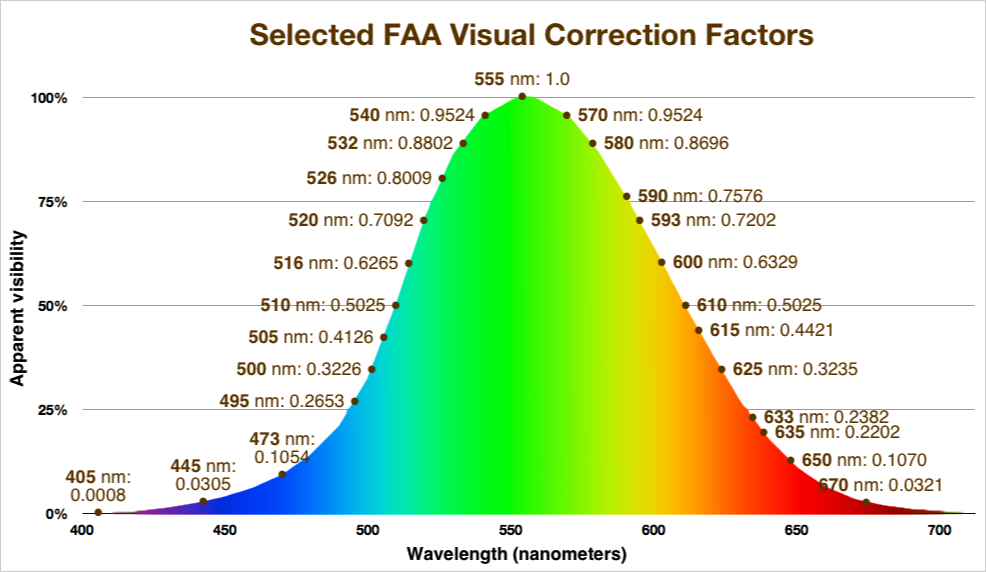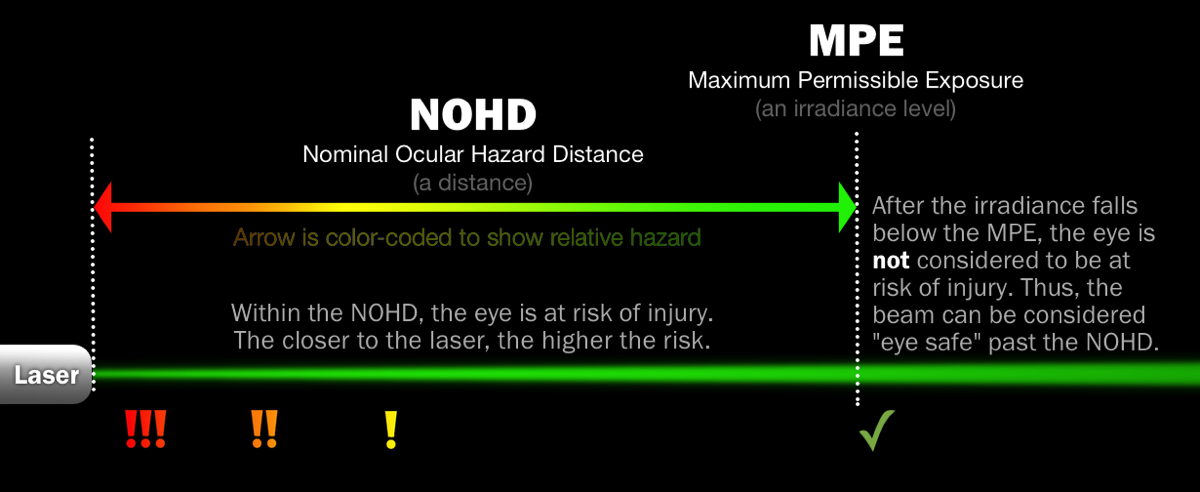Home
A comprehensive resource for safe and responsible laser use

NOTICE: CALCULATOR WILL NOT WORK
This calculator will not work with Internet Explorer. You appear to be running Internet Explorer or another incompatible browser; if so, all the results will be “.000”.
To allow this calculator to work, please use an up-to-date version of a browser such as Microsoft Edge, Mac Safari, Google Chrome, Firefox, etc. If you continue to have problems, contact us.
Laser Hazard Distance Calculator
- For more information on what these hazard distances mean, and on the equations behind the calculations, see the Laser hazard distance equations page.
- For a quick, at-a-glance comparison of various laser powers and colors, see the Laser hazard distances chart.
- To calculate beam diameter and irradiance at a specified distance, use the Beam Diameter and Irradiance Calculator.
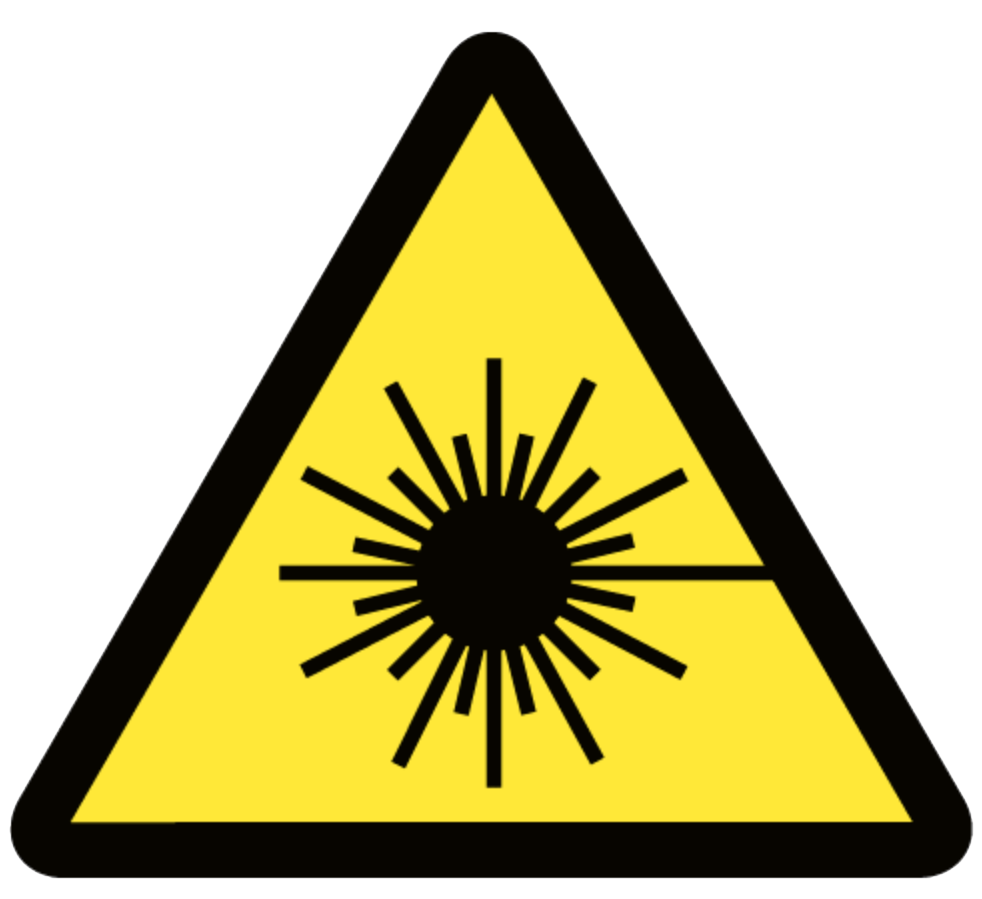
The milliwatt, milliradian and VCF inputs are color-coded to match the Laser hazard distance equations on which this calculator is based.
If you know the power in watts, multiply the watts by 1000 to get milliwatts. For example, for a 1.5 watt laser, enter 1500; for a 40 watt laser enter 40000.

Within the NOHD, the irradiance will be above the MPE, which is potentially hazardous. However, being exposed to laser light within the NOHD does NOT mean that a person will automatically receive an eye injury, or even is likely to have an injury.
The NOHD is a “nominal” hazard distance, not an actual hazard distance. The closer a person is to the laser, the greater the potential hazard — as shown by the colors in the diagram.

At the ED50 distance, there is roughly a 50-50 chance that a fixed laser beam aimed into an unmoving eye under laboratory conditions will cause the smallest medically detectable change to the retina. Such small changes can heal — just as small skin cuts and burns can heal with no adverse effect.
Between the ED50 distance and the NOHD, there would be even less of a chance of the laser beam causing the smallest medically detectable change to the retina. Beyond the NOHD, it is considered safe or “a negligible probability of damage.”
-
About laser eye hazards
- Laser beams get wider with distance. As the beam power becomes spread over a larger and larger area, the amount of light entering a pupil decreases:
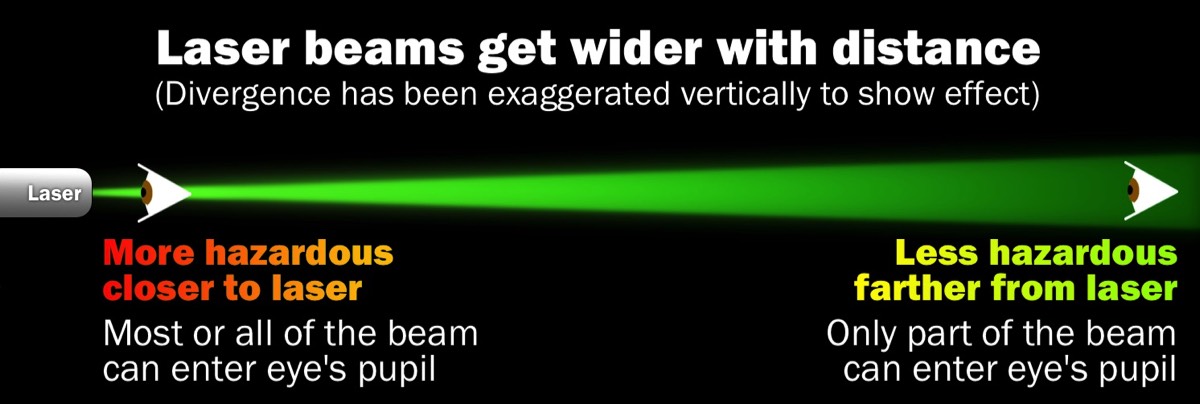 At some distance from the laser, the light intensity (irradiance) will be at the Maximum Permissible Exposure (MPE). This distance is called the Nominal Ocular Hazard Distance (NOHD):
At some distance from the laser, the light intensity (irradiance) will be at the Maximum Permissible Exposure (MPE). This distance is called the Nominal Ocular Hazard Distance (NOHD):Click to enlarge diagram
Closer than the NOHD, the irradiance is above the Maximum Permissible Exposure and is potentially hazardous. The closer a person is to the laser, the greater the potential hazard — as shown by the colors in the diagram.
At and farther than the NOHD, the laser light is generally considered eye safe. Specifically, at and farther than the NOHD there is “a negligible probability of damage” according to the laser safety standard ANSI Z136.1. The farther one gets from the NOHD, the lower the irradiance, meaning that the light is even safer. -
How to make beams safer
- A laser beam can be made safer by increasing its divergence (beam spread), lowering its power, and reducing the exposure time. The first two options are discussed below. (For reduced exposure times, see the section "What are some other MPE values?")
How divergence affects hazard distances
If a laser’s divergence is increased, the hazard distances directly decrease. For example, doubling the divergence will reduce the hazard distances by half:

Color indicates the relative hazard: Red = potential injury, green = unlikely injury. Beyond the Nominal Ocular Hazard Distance, the chance of injury is “vanishingly small” according to safety experts.
The diagrams above depict the NOHD being reduced by half. This reduction also applies to skin and fire hazard distances, and to the visual interference distances (flashblindness, glare and distraction). Doubling a laser’s divergence will reduce all of these hazard distances by half.
Usually, the more powerful a laser, the larger the typical divergence of the laser.
To increase the divergence of a beam (make it safer), use a lens to enlarge the beam. For laser light shows, a divergence of about 5 milliradians gives a larger beam without it being too “fat” or “fuzzy.”How laser power affects hazard distances
If a laser’s power is decreased, the hazard distances are shorter by the square root of the power decrease. Going from a 500 mW to a 5 mW laser is a 100 times power decrease; the hazard distances become 10 times shorter. (The square root of 100 is 10.)

This effect is a bit of good news for pilots and others concerned about increasing laser powers.
Looking at it the other way around — what is the effect of consumers obtaining more powerful lasers — the hazard distances (NOHD and visual interference) will increase less than one might expect.
A laser 100 times as powerful does not increase the NOHD hazard distance 100 times. The NOHD increases only 10 times (assuming the divergence remains the same).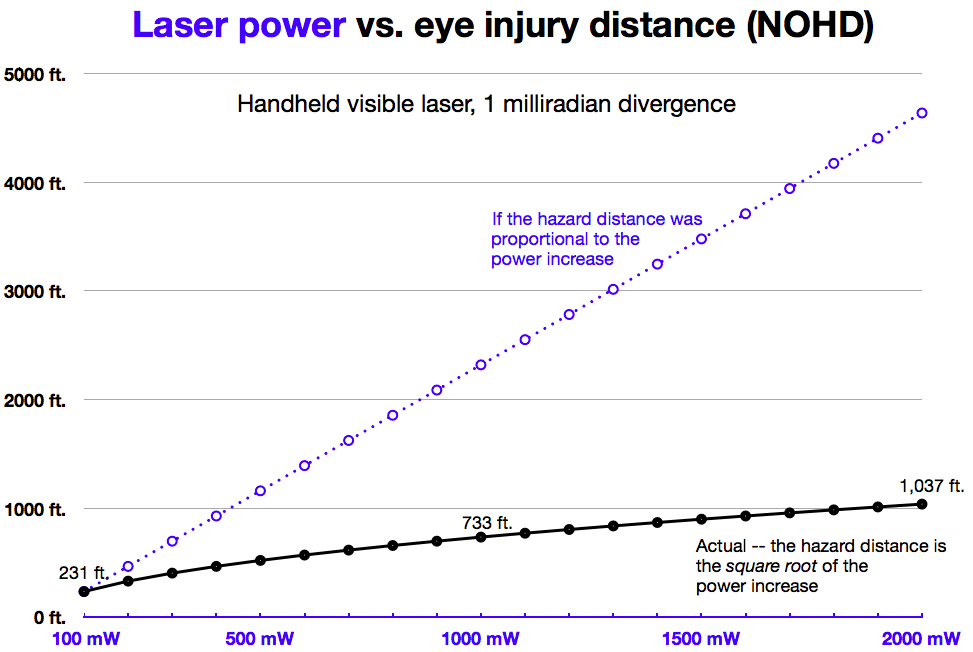
Click to enlarge diagram
-
MPE is derived from the ED50 distance
- The MPE light level (irradiance) was set by laser safety experts to be one-tenth of the ED50 irradiance. Said another way, the ED50 irradiance is 10 times the Maximum Permissible Exposure (MPE).
This gives an added “safety margin” or “reduction factor” that is 10 times the where injury barely occurs. -
ED50 irradiance vs. ED50 distance
- The ED50 irradiance is 10 times the MPE irradiance, while the ED50 distance is a little less than 1/3 the NOHD distance.
This is due to the inverse square law of light. The ED50 distance is the square root of 10, or 0.316 times the NOHD. -
What "ED" means in "ED50"
- “ED” means “Effective Dose.” This term comes from pharmacology, where ED50 refers to the dose of a drug that produced an effect in 50% of the population that took the drug during testing.
By analogy, the ED50 of laser light is the amount of light (irradiance) that produces a minimally visible change to the retina. As stated above, the MPE was set by laser safety experts to be 10 times the ED50, in order to give a “safety factor” or “reduction factor.” -
What is the MPE for this calculator?
- As stated at the top of this calculator, the results are valid only for visible light exposures of less than 1/4 second, from continuous wave (not pulsed) lasers.
A person would be expected to see the visible laser light and to automatically blink and/or turn away in 1/4 second or less. This is called the aversion reflex.
For an eye exposure of 1/4 second to visible continuous wave laser light, the Maximum Permissible Exposure irradiance is 2.5 milliwatts per square centimeter. (The ED50 irradiance is 10 times this, or 25 mW/cm2.)
The NOHD for a 1/4 second exposure is calculated to be the distance where the beam irradiance just reaches 2.5 mW/cm2. Beyond this, the irradiance will be lower and beam is considered safe for direct eye exposure of 1/4 second or less. -
What are some other MPE values?
- The Maximum Permissible Exposure varies depending on the laser's operating mode (continuous wave or pulsed), wavelength, exposure duration, and whether the exposure is to Eye, Skin or materials.
For longer exposures, the Eye MPE will be lower (requiring dimmer light). Conversely, for shorter exposures, the MPE will be higher (allowing brighter light).Calculating exact Eye MPE values
For eye exposures between 18 microseconds (18 μsec or 0.000018 sec) and 10 seconds, you can use the following formula to determine the continuous wave visible light MPE, where t is the time of exposure in seconds:(t 0.75 x 1.8) ÷ t
The answer will be in mW/cm2.
To calculate t to the 0.75 power, use a scientific calculator with a "xy" button. Enter the time in seconds, press the xy button, then 0.75, then the equals button.
Below is an example showing a calculator app with an xy button, and how to calculate the MPE for a 3 second duration.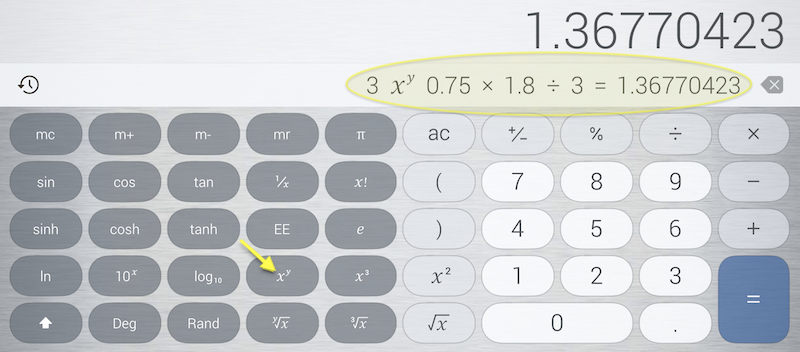
Selected Eye MPE values
Here are some Eye MPE values for selected exposure durations. These are the maximums; you are not allowed to exceed this value, for the exposure duration listed.- 10 seconds: 1.01 mW/cm2
- 1 second: 1.80 mW/cm2
- 0.25 second: 2.5 mW/cm2. This value is used for accidental, unwanted exposure to visible light, where a person is expected to blink and/or turn away within 1/4 second of experiencing a bright light.
- 0.1 second: 3.20 mW/cm2
- 0.01 second: 5.69 mW/cm2
- 0.001 second: 10.1 mW/cm2
- 0.0001 second: 18.0 mW/cm2
- 0.000018 microseconds: 27.6 mW/cm2
For longer exposures such as 10 minutes or 8 hours, the MPE is wavelength dependent. For example, the Eye MPE for a 10 minute exposure to red 633 nm laser light is 0.253 mW/cm2; for blue-green 514 nm laser light it is 0.0167 mW/cm2.
The formula and values come from the laser safety standard ANSI Z136.1.
These three visual interference distances are used by the U.S. Federal Aviation Administration to determine how far a laser beam can travel before it falls below the irradiance limits in a Sensitive, Critical or Laser Free zone.
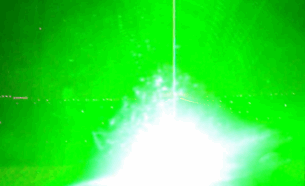
To avoid this, within the SZED the irradiance would be below 100 μW/cm2 (0.1 mW/cm2).
Further than the SZED, the laser light is not expected to cause temporary flash blindness or an afterimage — but it will cause glare.
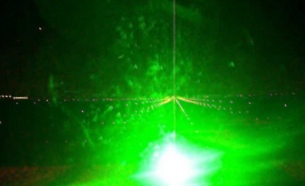
To avoid this, within the CZED the irradiance would be below 5.0 μW/cm2 (0.005 mW/cm2).
Further than the CZED, the laser light is not expected to cause significant or blinding glare — but it will be distracting.
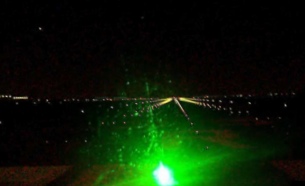
To avoid this, within the LFZED the irradiance would be below 50 nanowatts/cm2 (this is 0.05 μW/cm2 or 0.00005 mW/cm2).
Further than the LFZED, the laser light is not expected to be distracting. It will not be brighter than other city or airport lights seen outside the cockpit window.
-
Diagrams of FAA flight zones
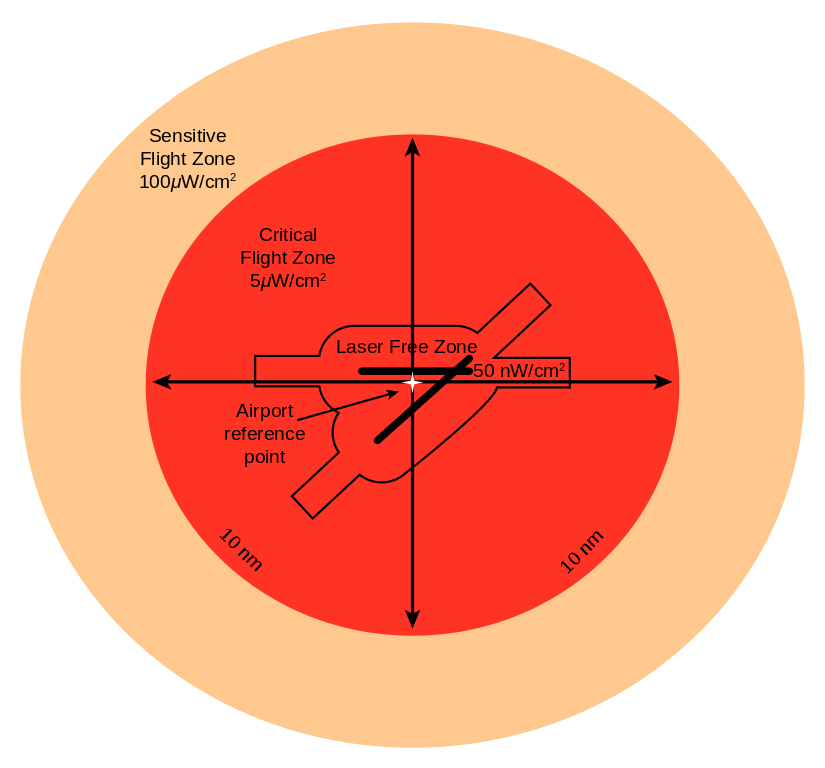 The U.S. FAA Critical Flight Zone extends horizontally 10 NM (19 km) around the airport, and extends vertically to 10,000 feet (3,000 m) above ground level.
The U.S. FAA Critical Flight Zone extends horizontally 10 NM (19 km) around the airport, and extends vertically to 10,000 feet (3,000 m) above ground level.
The optional Sensitive Flight Zone is designated around special airspace needing bright-light protection. Not all airports will have a Sensitive Flight Zone around them.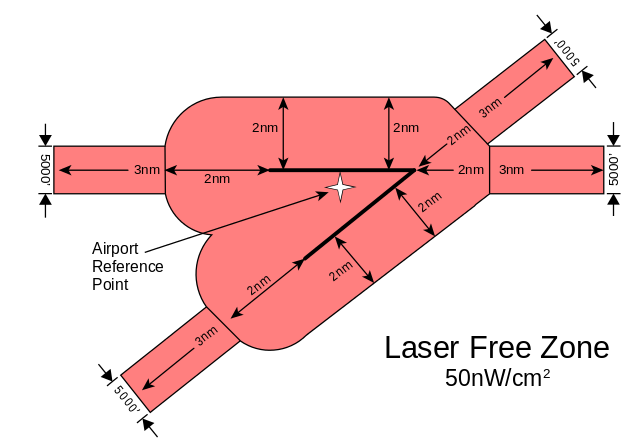 The U.S. FAA Laser Free Zone extends horizontally 2 NM (3,700 m) from the centerline of all runways (two dark lines in this diagram) with additional 3 NM (5,560 m) extensions at each end of a runway. Vertically, the LFZ extends to 2,000 feet (610 m) above ground level.
The U.S. FAA Laser Free Zone extends horizontally 2 NM (3,700 m) from the centerline of all runways (two dark lines in this diagram) with additional 3 NM (5,560 m) extensions at each end of a runway. Vertically, the LFZ extends to 2,000 feet (610 m) above ground level.-
Caution when the VCF is less than 0.0395
- CAUTION: If any of the visual interference distances — SZED, CZED or LFZED — are less than the NOHD, then use the NOHD instead. This is to avoid cases such as a blue or red beam which appears so dim to the eye that it has a short visual interference distance, but can still be an eye hazard to a greater distance. The goal is to not allow a person to be exposed at a distance shorter than the NOHD.
Take for example a deep blue 445 nm laser. Enter the VCF of 0.0305 in the calculator. The SZED will be less than the NOHD, no matter what the power or divergence. If you were filling out the FAA Advisory Circular 70-1 “Laser Configuration Worksheet,” you would be required to enter “Less than NOHD” in the SZED space. -
Just don't hit aircraft!
- The three visual interference distances SZED, CZED and LFZED are submitted to FAA using Advisory Circular 70-1. This is because FAA wants to know how far from the laser that flashblindness, glare and distraction can occur.
However, for persons with laser pointers and those doing laser light shows, these distances are academic. This is because FAA requires these users to simply not hit aircraft.
It does not matter if you can show that your laser was beyond the Laser Free Zone Exposure Distance, and thus was not a distraction to the pilot.- For laser pointer users, U.S. federal law prohibits knowingly aiming the beam at an aircraft. (Plus, laser pointer users do not have to submit outdoor uses in advance to FAA.)
- For laser light show producers, FAA will object to a show that illuminates an aircraft. You will be required to use spotters or other techniques to detect aircraft and shut off the beam if it would go towards an aircraft.
-
How laser color affects hazard distances
- For visible lasers, the wavelength (color) does not affect the eye hazard (NOHD), skin hazard or fire hazard distances. But wavelength does affect the three visual interference distances: Flashblindness, glare and distraction.
The human eye is most sensitive to green light of 555 nanometers. This color would appear brightest, and most distracting to pilots, compared to other colors from an otherwise equivalent laser (e.g., having the same power and divergence).
Most consumer lasers emit green light at 532 nanometers. This appears to the eye only 88% as bright as 555 nm light. Because it is so common, we will use 532 green as the baseline for “brightest available laser” in the following calculations:- Compared with 532 nm light, the common red wavelength 635 nm appears only 27% as bright. This has a square root effect on the visual interference distances. A 532 green laser appears 4 times as bright as a 635 red laser -- but the green visual interference distances are only 2 times the red distances. (The square root of 4 is 2.)
- Compared with 532 nm light, the common blue wavelength 445 nm appears only 3.5% as bright. Again, there is a square root effect on the distances. A 532 green laser appears 29 times as bright as a 445 blue laser -- but the green visual interference distances are only 5.4 times longer than the blue distances. (The square root of 29 is 5.4.)
The diagrams below show how the beam color affects a visual interference distance — the flashblinding distance in this particular case:

 Note that since all three lasers have the same power and divergence, the NOHD for these would be equal. It is only the visual interference distances that will change based on the wavelength.
Note that since all three lasers have the same power and divergence, the NOHD for these would be equal. It is only the visual interference distances that will change based on the wavelength.
Additional laser hazard calculators
To calculate beam diameter and irradiance at a specified distance, use the calculator here.
We also have information about other calculators and dedicated programs. These can analyze complex situations involving multiple simultaneous colors, pulsed lasers, non-visible lasers, and/or atmospheric attenuation.
If you are a member of the International Laser Display Association, you can use ILDA’s free online Skyzan professional laser hazard calculator.

